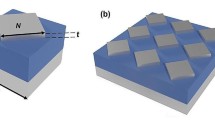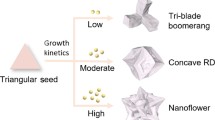Abstract
This work reports on a numerical simulation study regarding the systematic tuning of plasmonic resonance wavelength in the mid-infrared regime, by using composite arrays of graphene ribbons. On top of a glass substrate, a variety of composite arrays that consist of graphene ribbons are carefully designed. The layer numbers of the multi-layer graphene ribbons and the Fermi energy levels of the graphene are respectively varied, and the corresponding light transmittance is calculated in the mid-infrared wavelength range from 4 to 20 μm, via the finite difference time domain (FDTD) method. The results reveal that the plasmonic resonance wavelength associated with the graphene arrays can be tuned in the mid-infrared wavelength range by adjusting the parameters of the arrays. Based on the study, we suggest that the structure of the graphene composite arrays proposed in this work be implemented in the design for plasmonic tuning devices at mid-infrared wavelengths.











Similar content being viewed by others
References
Stanley R (2012) Plasmonics in the mid-infrared. Nat Photonics 6:409–411
Soref R (2010) Mid-infrared photonics in silicon and germanium. Nat Photonics 4:495–497
Grigorenko AN, Polini M, Novoselov KS (2012) Graphene plasmonics. Nat Photonics 6:749–758
Bao Q, Loh KP (2012) Graphene photonics, plasmonics, and broadband optoelectronic devices. ACS Nano 6:3677–3694
Pala RA, Shimizu KT, Melosh NA, Brongersma MLA (2008) Nonvolatile plasmonic switch employing photochromic molecules. Nano Lett 8:1506–1510
MacDonald KF, Samson ZL, Stockman MI, Zheludev NI (2009) Ultrafast active plasmonics. Nat Photonics 3:55–58
Dionne JA, Diest K, Sweatlock LA, Atwater HA (2009) PlasMOStor: a metal-oxide-Si field effect plasmonic modulator. Nano Lett 9:897–902
Liu M, Yin X, Ulin-Avila E, Geng B, Zentgraf T, Ju L, Wang F, Zhang XA (2011) Graphene-based broadband optical modulator. Nature 474:64–67
Bludov YV, Vasilevskiy MI, Peres NMR (2010) Mechanism for graphene-based optoelectronic switches by tuning surface plasmon-polaritons in monolayer graphene. Europhys Lett 92:68001
Gan CH, Chu HS, Li EP (2012) Synthesis of highly confined surface plasmon modes with doped graphene sheets in the midinfrared and terahertz frequencies. Phys Rev B 85:125431
Yan H, Li X, Chandra B, Tulevski G, Wu Y, Freitag M, Zhu W, Avouris P, Xia F (2012) Tunable infrared plasmonic devices using graphene/insulator stacks. Nat Nanotechnol 7:330–334
Liu P, Cai W, Wang L, Zhang X, Xu J (2012) Tunable terahertz optical antennas based on graphene ring structures. Appl Phys Lett 100:153111
Jablan M, Buljan H, Soljacic M (2009) Plasmonics in graphene at infrared frequencies. Phys Rev B 80:245435
Gao W, Shu J, Qiu C, Xu Q (2012) Excitation of plasmonic waves in graphene by guided-mode resonances. ACS Nano 6:7806–7813
Ju L, Geng BS, Horng J, Girit C, Martin M, Hao Z, Bechtel HA, Liang XG, Zettl A, Shen YR, Wang F (2011) Graphene plasmonics for tunable terahertz metamaterials. Nat Nanotechnol 6:630–634
FDTD Solutions, www.lumerical.com
Hanson GW (2008) Dyadic Green’s functions and guided surface waves for a surface conductivity model of graphene. J Appl Phys 103:064302
Stauber T, Peres NMR, Guinea F (2007) Electronic transport in graphene: a semiclassical approach including midgap states. Phys Rev B 76:205423
Tan YW, Zhang Y, Bolotin K, Zhao Y, Adam S, Hwang EH, Sarma SD, Stormer HL, Kim P (2007) Measurement of scattering rate and minimum conductivity in graphene. Phys Rev Lett 99:246803
Chu HS, Gan CH (2013) Active plasmonic switching at mid-infrared wavelengths with graphene ribbon arrays. Appl Phys Lett 102:231107
Gusynin VP, Sharapov SG, Carbotte JP (2007) Sum rules for the optical and Hall conductivity in graphene. Phys Rev B 75:165407
Casiraghi C, Hartschuh A, Lidorikis E, Qian H, Harutyunyan H, Gokus T, Novoselov KS, Ferrari AC (2007) Rayleigh imaging of graphene and graphene layers. Nano Lett 7:2711–2717
Li HJ, Zhai X, Sun B, Huang ZR, Wang LL (2015) A graphene-based bandwidth-tunable mid-infrared ultra-broadband plasmonic filter. Plasmonics 10:765–771
Kim M, Lee S, Kim S (2015) Plasmon-induced transparency in coupled graphene gratings. Plasmonics 10:1557–1564
Author information
Authors and Affiliations
Corresponding author
Rights and permissions
About this article
Cite this article
Sun, C., Wang, X. Plasmonic Tuning at Mid-Infrared Wavelengths by Composite Arrays of Graphene Ribbons. Plasmonics 12, 1235–1243 (2017). https://doi.org/10.1007/s11468-016-0381-4
Received:
Accepted:
Published:
Issue Date:
DOI: https://doi.org/10.1007/s11468-016-0381-4




